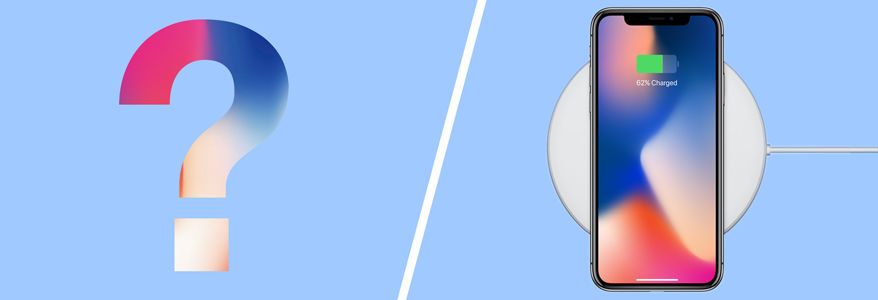
Buzz / 09 27, 2017
iPHONE X: HOW IT'S IMPACTING MOBILE APP DESIGNERS & DEVELOPERS
Apple’s “Future Phone” has been announced and will be available on November 3rd.
The iPhone X will offer up some new features not available on current iPhones, complete with a new interface, larger screen and a whole new way to unlock it. We took a few moments to ask some of our experts what their thoughts were and how this will impact both design and development in their current workflows.

“As a mobile app designer, the new iPhone X will mean that I have to work with one more screen size. The iPhone 8 won’t be an issue; things will stay as they are in regards to workflow and process. The iPhone X will require some thought in the flex areas of the screen. With the extra vertical 145 pts, we need to determine what the scalable areas of the screen will be. If we stick to using standard iOS controls, this will not be an issue. But if we start using some custom views, we might have some bigger roadblocks to get it to look right on all screens.
What do we designers do about the notch? We can’t draw attention to, or do anything to hide, or minimize the notch. The margins on the phone have been updated to allow for the notch, so certain views can be letterboxed depending on the devices and layout.
The new screen-edge gestures are an unknown, too. The iPhone X allows different gestures to be used on the edge for the home switcher, app switcher, notification, and control center. These need to not interfere with the standard gestures used on the main screen. This is for the iPhone X only, so when thinking about gestures, we need to make sure we aren’t causing any confusion or conflicts.
With Apple releasing two new phones at the same time (the iPhone 8 and iPhone X), it means they will get user feedback on features that could end up making their way into the mainstream or die quietly in the night. I don’t think it’s a shift in doing something different. This is the kind of thing they have done for years.
The iPhone X killed the Touch ID. Touch ID was extremely easy to use and seamless. But I remember when Touch ID was first introduced, it was bug ridden and took a while to get the kinks worked out. I see the same thing happening with the facial recognition. It will be flawed and buggy, but eventually it will get the kinks out, and eventually, it will work its way into the mainstream. But this is not because the market demands it, but because Apple is forcing you to adapt to its new security.
I personally think it is clunky, and I am not a fan of this new UI. Taking your phone out of your pocket with your thumb on the home button was a seamless interaction. It sounds trivial, but having to raise the phone up high enough to read your face will take longer and cause more trouble. Also, there will now be the perception to people who do not know you’re unlocking the phone, who will now think you’re taking a selfie while waiting to unlock your phone at the check-out line, or while driving.”
Daniel Herman, Associate Design Director

“There are a surprising amount of challenges that affect both designers and developers with the release of the iPhone X. The one that comes to mind to most people is obviously the rounded corners on the X and the notch. The lesser known-and bigger issue is the change in aspect ratio for the iPhone X from the earlier version of the iPhone 6, 7, and 8 models.
Accounting for this new aspect ratio will affect every single app on the app store in some way. With the iPhone 6, 7, and 8, designers could get away with a lot more because the aspect ratios between the devices were the same. This change in aspect ratio will challenge designers to account for how their designs look across two major emerging lines of products: the X and the 8. There may have to be compromises in some designs to account for which product companies want to build for.
The new iPhone will not affect developers’ workflows too much, except when they need to lay out the views created by the designers. This might take some time to get used to but will not be too much of a hiccup. It will still require a small change in thinking.
With the release of the iPhone X, I think Apple is interested in making premium versions of their products that are differentiated from their regular models. I would not be surprised to see X versions of the iPad and the Apple Watch made available when the time is ready.
I think people are going to really enjoy the facial recognition capabilities of the device. I am very interested in seeing where Apple takes it. With the expressive emojis, there is no doubt that Apple is interested in people expressing themselves through the facial recognition technology.
My guess is that they want to use facial tracking to capture your emotional state while using the phone. This would create a whole new world of possibilities with the iPhone in future releases, especially with Siri. If Siri is able to capture your emotional state while using your phone, she might be able to tweak her suggestions and respond to how you are feeling while you use your phone. It could also allow your phone to know you at an even more personal level than it already does.
Overall, I think these changes to their devices are a much-needed step for Apple, and I am looking forward to all of the possibilities that these new technologies will bring.”
Joe Edwards, iOS Developer

“I think the new iPhone X form factor will mean a lot of discussions between designers and developers to work out design changes. Between the bigger status bar, the notch, the curved corners, and the new aspect ratio, we have a lot to work out. At first, I expect that the edges of the X screen will be blank. A screen that goes to the edge of the phone won’t matter much if developers and designers can’t use the real estate effectively.
As for Apple releasing the 8 and X at the same time, I’m confused. Are these devices expected to cover different markets? I’m not sure I get the point.
I’m not a big fan of biometric unlocking because it isn’t flexible–I can’t change my face as easily as I can change my password– but it’s not like phone unlocking needs to be all that secure, so maybe it’s not an issue. Apple is already worrying about “creative” uses of the system, as seen in the guidelines, where they restrict the use of the facial mapping tools. Such tools are going to make for a very interesting future.”
Daniel Tartaglia, Senior iOS Developer

“I’m excited for the iPhone X, the edge-to-edge screen represents a major shift in user experience. I think the change will be positive overall, but I’m concerned with the transition period as a developer. Apple has always been well ahead of Android in providing a consistent user experience, which allowed a consistent developer experience. The first hiccup that developers experienced was during the transition from iPhone 4 to iPhone 5, when we had to support multiple aspect ratios. I believe supporting both older model iPhones and the iPhone X will be slightly more complex from a developer standpoint, but I don’t expect any major headaches. I anticipate that within a product cycle or two all phones will have the edge-to-edge displays, this is very much in line with the original vision for Apple’s tablet computer.
The largest unknown with the iPhone X is how well the facial recognition feature works. If it works well, I think we’ll see very happy customers and an improved user experience. If it works poorly, we’ll see a lot of people reverting to passcodes. I was one of the people that could not use Touch ID until the iPhone 7 was released, so I’m familiar with the frustration of using a half-working system for something so integral to the experience. The good thing about the facial recognition is that it can be massively improved via software updates where Touch ID could not.”
Jesse Curry, Director of Development Services
The new iPhone presents an overwhelming amount of changes both on the front-end for mobile app designers and on the back-end for mobile app developers. Only those who are prepared to adapt to the iPhone X will come out on top in embracing these new trends set by Apple. Stay tuned for November 3rd to see how both consumers and developers embrace iPhone X!



